
dMEV SELV Fan Range
Installaon and Operang Guide
Page 2 of 16 Page 3 of 16 Page 4 of 16
Page 5 of 16 Page 8 of 16
Mechanical Installation - Wall
The fan can be mounted “landscape”, with the release
buttons facing downwards or “portrait” with the buttons
on the right hand edge. The fan requires a 110mm
diameter hole through the external wall lined with a
100mm internal diameter duct kit. To recess the fan a
hole of 195 x 175 x 80mm deep is required.
Important: refer to the enclosed mounting template in
the box for location of recess and fixing screws relative
to the exhaust ducting.
LOOVENT eco
Power connections are made through the terminal
block as shown below. Prepare the cable by leaving a
length of 60mm protruding from inside the base of the
fan. Strip the conductor insulation back by 5mm and
connect to the terminal block (see page 5). Once
connections have been made, clip the terminal block
back into location as shown below.
Note - When inserting the fan module
into the body, locate the rectangular
holes in the fan housing on the lugs in
the base, holding the left hand side of
the fan module
slightly raised.
Lower the fan
module gently
until the
retaining
screws touch
their respective
inserts.
Secure with
fixing screws.
Note: All LOOVENT eco dMEV SELV fans are fitted
with a safety feature which means the fan will not run
without the front cover secured. Secure the front cover
before attempting to start the fan.
Page 7 of 16
Fan dimensions
Page 6 of 16
80000573 Issue 1 03/17
LVECODST - 72684312
LVECODSHT - 72684313
Fan overview
1
2
3
Range overview
LOOVENT eco dMEV SELV fans are designed for
ventilation of domestic premises. They can be
recessed or surface mounted in walls or ceilings, in a
portrait or landscape orientation.
Continuous Operation
Continuous Operation has three trickle speeds, 7,9 and
16 l/sec as well as two boost speeds 15, and 31 l/sec.
These speeds are selectable on install by using the
restrictor cone and dip switch settings found on P14.
More information on dip switches and the 2 minute
delay boost feature found on P11.
LVECODST - Continuous operation on selected Trickle
flow rate. Boost flow rate activated via switch live or
pull cord with an adjustable timer overrun from 2 to 45
minutes.
LVECODSHT - Continuous operation on selected
trickle flow rate. Boost flow rate activated via switch
live, pull cord, or 40-90% adjustable humidity sensor,
with an adjustable timer overrun from 2 to 45 minutes.
Intermittent Operation
Intermittent operation mode has two speeds, 17 & 31 l/
sec as well as a 2 minute delay start function
selectable on install using by dip switches (more
information on P11). All models also include a
momentary pull cord which does not click when used.
LVECODST - Activation of selected speed via switched
live with an adjustable timer overrun from 2 to 45
minutes. Pull cord activation will always run at 31 l/sec
speed.
Front cover removal
To remove front cover, apply finger pressure to the two
semi-circular buttons at the edge of the cover (see
below). To remove the cover completely, pivot it to 90°
and lift away (see below). To refit, reverse the above
procedure.
Fan module removal
Remove the accessories from the body of the fan. The
fan module is released by undoing the two retaining
screws alongside the fan housing (see below). Lift the
left side of the module as viewed slightly and slide to
the right to release from the two lugs in the base (see
below). When the
module is removed
the terminal block
will be attached to
the back of the
module. This
should be removed
to enable wiring.
1 - Front Cover
2 - Fan Module
3 - Outer Casing
4 - Restrictor Cone
Screw
Screw
Lugs
4
Intermittent Operation Cont’d
LVECODSHT - Activation of selected speed via
switched live with an adjustable timer overrun from 2 to
45 minutes. Humidity sensor can be adjusted between
40 to 90%. Activation of fan via humidity will always
run at 31 l/sec speed. Pull cord activation will always
run at 31 l/sec speed.
Electrical installation
The LOOVENT eco dMEV SELV fan range is IPX5 rated and
is suitable for mounting in Zone 1 when installed with a 30mA
RCD.
The fan requires a 220 - 240V 50/60Hz single phase supply.
Class II equipment. BS EN 60417. An external 3A fuse is
required for each fan unit. Cable sizes (max): Fixed flat wiring
2 core 1mm
2
, 3 core 1/1.5mm
2
All electrical installation work to be carried out by a
competent person in compliance with the relevant Building
Regulations/Standards as well as the current edition of
BS7671 (IET Wiring Regulations).
Important notes
The LOOVENT eco dMEV SELV range also complies with
the requirements of the EU norms and directives. Do not
place the ventilator near direct heat sources, e.g. radiant
heaters, or where temperatures can exceed 40°C (104°F).
Precautions must be taken to avoid back flow of gases in
rooms with open flue fuel burning appliances. The power
supply unit (12V DC transformer) supplied with the fan,
should be fitted outside of Zones 0,1 & 2 usually outside the
room. The maximum length of wire between the power
supply and the fan should not exceed 5m using 1.5mm2 wire.
Never cover the power supply unit with thermal insulation
materials.
Wiring for fans with external switching
Electrical installation
SELV Power Supply
Wiring for fans with no external switching
(Pull cord and feature activation only i.e. Humidity)

Page 9 of 16
Page 13 of 16 Page 14 of 16
Page 15 of 16
Installation with flexible ducting
Where flexible ducting is used the diameter must be
maintained and it is good ventilation practice that the
ducting is extended to 90% of its possible length in
order to maintain the best possible airflow. Ensure that
flexible duct connections are not over tightened to the
fan outlet spigot. To maximise airflow rigid ducting
should be used. The fan and ducting should be
installed in accordance with the requirements of the
Domestic Ventilation Compliance Guide, part of the
Building Regulations.
Maintenance
SAFETY FIRST: ALWAYS ISOLATE THE FAN UNIT FROM
THE POWER SUPPLY BEFORE REMOVING THE COVER.
When installed according to these instructions the LOOVENT
eco range is completely safe. The materials used do not
constitute a hazard.
Cleaning
The external housing of the fan can be wiped with a damp
cloth. Do not use household cleaners containing abrasives.
Note: Always isolate the fan when cleaning. Never clean any
parts of the fan assembly by immersing in water or using a
dishwasher.
Warning
This appliance can be used by children aged from 8 years and
above and persons with reduced physical, sensory or mental
capabilities or lack of experience and knowledge if they have
been given supervision or instruction concerning use of the
appliance in a safe way and understand the hazards involved.
Children shall not play with the appliance. Cleaning and user
maintenance shall not be made by children without
supervision.
Warranty
Applicable to units installed and used in the United Kingdom.
Airflow Developments Ltd guarantees the LOOVENT eco
SELV for 5 YEARS from date of purchase against faulty
material or workmanship. Warranty only covers the fan, not the
reinstallation of this if required. In the event of any defective
parts being found, Airflow Developments Ltd reserve the right
to repair or at our discretion replace without charge provided
that the unit:
1. Has been installed and used in accordance with the fitting
and wiring instructions supplied with each unit.
Warranty cont’d
2. Has not been connected to an unsuitable electrical supply.
3. Has not been subjected to misuse, neglect or damage.
4. Has not been modified or repaired by any person not author-
ised by Airflow Developments Ltd
5. Has been installed in accordance with latest Building Regu-
lations and IEEE wiring regulations by a recognised competent
installer.
Airflow Developments Ltd shall not be liable for any loss, injury
or other consequential damage, in the event of a failure of the
equipment or arising from, or in connection with, the equipment
excepting only that nothing in this condition shall be construed
as to exclude or restrict liability for negligence.
This warranty does not in any way affect any statutory or
other consumer rights.
Page 16 of 16
Page 10 of 16
Restrictor Cone
All LOOVENT eco dMEV SELV
fans are supplied with a restrictor
cone to increase the air velocity.
This is supplied as a two part
assembly and should be clipped
together and secured with
adhesive tape (not included) to
the spigot of the fan. The cone is
only required for continuous trickle
ventilation as per the table on
P14. Normal 100mm ducting
should still be connected to the
spigot of the fan and not to the
cone outlet.
Page 11 of 16
UK Head-Office
AIRFLOW DEVELOPMENTS Limited
Aidelle House, Lancaster Road
Cressex Business Park
High Wycombe
Buckinghamshire
HP12 3QP
United Kingdom
Tel: +44 (0) 1494 525252
Fax : +44 (0) 1494 461073
Email: info@airflow.com
Web: airflow.com
Czech Republic
AIRFLOW LUFTTECHNIK GmbH
organizační složka Praha
Hostýnská 520
108 00 Praha 10
Czech Republic
Tel: +42 (0) 2 7477 2230
Fax: +42 (0) 2 7477 2370
Email: info@airow.cz
Web: airow.cz
Germany
AIRFLOW LUFTTECHNIK GmbH
Posach 1208
D-53349 Rheinbach
Germany
Tel: +49 (0) 222 69205 0
Fax: +49 (0) 222 69205 11
Email: info@airow.de
Web: airow.de
AIRFLOW DEVELOPMENTS LTD reserve the right in the interest of connuous development to alter any or all specicaons without
prior noce.
Mechanical Installation - Ceiling
When recessing fans in the ceiling, a plywood support
panel (min 18mm thick) should be fixed between the
ceiling joists to support the fan (see below) 80 to 85mm
from the ceiling. The LOOVENT eco dMEV SELV
requires a 110mm diameter hole through the support
panel and a rectangular cut-out in the ceiling board.
(Refer to the enclosed mounting template for shape,
size & location of the recess relative to the 110mm
diameter hole). With the screws provided, fix the fan to
the support panel.
Fan Adjustment
When viewed in the
landscape orientation, all
adjustment of the fans
features is done through
a combination of dip
switches and rotating
potentiometers found on
the bottom left hand
corner of the fan module.
This control panel will be
similar to the picture (see
right). Specific
adjustments such as
humidity will only be
available on certain models.
Run Timer - This adjusts the activation/boost timer
overrun of the fan from 2 to 45 minutes. Factory set to
approx. 20 mins. Rotating this clockwise will increase
the timer overrun towards 45 minutes, rotating anti-
clockwise will decrease the timer overrun towards 2
minutes. Adjustment of this setting should be done
using the included adjustment tool.
Humidity - This adjusts the relative humidity that the
fan will activate/boost at. Factory set to approx. 70%.
Rotating this clockwise will increase the RH%
activation towards 90%, this means the fan will activate
at high humidity levels. Setting this too high can result
in the fan never activating/boosting on humidity.
Rotating this anti-clockwise will decrease the RH%
activation towards 40%, this means the fan will activate
at low relative humidity levels. Setting this too low can
result in the fan continuously running/boosting.
Flow Rate - Has two settings and becomes factory set
to “L”. For intermediate mode this means the switch
live or motion sensor activation (if available) will run the
fan at 17 L/sec. When switched to “H” the switch live or
motion sensor activations will run the fan at 31 L/sec.
Continuous mode effects can be found on P14
Ventilation Control - Switches the device between
intermittent operation and continuous (dMEV)
operation.
X - is spare and has no function, this should be left on
the factory setting.
Delay Start/Boost - When switched “on” this will
enable the 2 minute delay start/boost which delays the
activation/boosting of the fan from the switched live
input. When switched “off” all activation/boost methods
will happen instantly when triggered i.e. switch live
input activated fan will instantly activate/boost.
X
Page 12 of 16
Good practice guide
To avoid the backflow
of condensation into
the fan in the ceiling
installations it is good
practice to fit a
condensation trap
(optional—See
www.airflow.com) to
the vertical outlet duct
of the fan.
Continuous Flow Rate Settings
Recommended Best Practice
The Building Regulations 2010, Statutory Instrument
Part 9, paragraph 42, imposes a requirement that
testing and reporting of mechanical ventilation
performance is conducted in accordance with an
approved procedure.
Compliance with this requirement by an assessed and
registered ‘Competent Person’ should follow a ‘Best
Practice’ process and adopt air flow measurement,
Method A – The Unconditional Method – using a
suitable UKAS certified measuring instrument.
Generically referred to as a ‘Zero Pressure Air Flow
Meter’ or ‘Powered Flow Meter’.
Further information on this method is detailed in NHBC
Building Regulations Guidance Note G272a 10/13 and
BSRIA ‘A Guide to Measuring air flow rates’ document
BG46/2015
(2 - 45 MIN.)
(40% - 90%)
-
 1
1
-
 2
2
Airflow LOOV-T dMEV SELV Operating instructions
- Type
- Operating instructions
- This manual is also suitable for
Ask a question and I''ll find the answer in the document
Finding information in a document is now easier with AI
Related papers
-
Airflow LOOV-T dMEV 240V Operating instructions
-
Airflow LOOVENT eco T Operating instructions
-
Airflow LOOVENT eco T Operating instructions
-
Airflow Aura Fan Operating instructions
-
Airflow LOOVENT eco SELV HT Operating instructions
-
Airflow PCS SELV Module Operating instructions
-
Airflow PRTMB Module (B) Operating instructions
-
Airflow Aria 100HT Operating instructions
-
Airflow iCONstant HT Operating instructions
-
Airflow ecoDRY mini White Operating instructions
Other documents
-
Vents Quiet-dMEV DC User manual
-
Envirovent ECO DMEV S User guide
-
 Envirovent Eco dMEV+ 17V Decentralised Mechanical Extract Ventilation Trickle User manual
Envirovent Eco dMEV+ 17V Decentralised Mechanical Extract Ventilation Trickle User manual
-
Xpelair LVDX200T User manual
-
Xpelair DX180T User manual
-
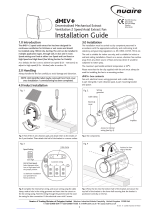 Nuaire dMEV+ Installation guide
Nuaire dMEV+ Installation guide
-
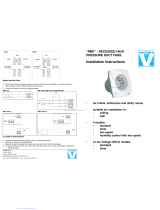 Vectaire RMF100 H2R Installation guide
Vectaire RMF100 H2R Installation guide
-
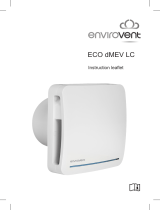 Envirovent ECO dMEV LC Installation guide
Envirovent ECO dMEV LC Installation guide
-
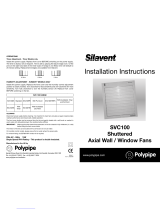 silavent SVC100 Installation guide
silavent SVC100 Installation guide
-
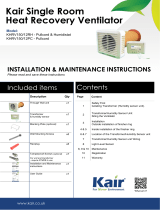 Kair KHRV150/12PC Installation & Maintenance Instructions Manual
Kair KHRV150/12PC Installation & Maintenance Instructions Manual







